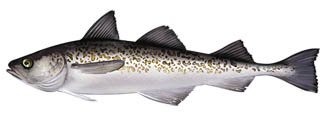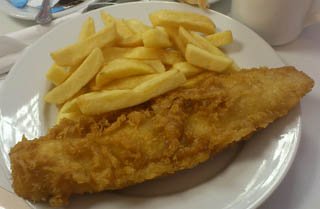Alaska pollock Nutrition facts
Alaska Pollock is a whitefish species that lives in the cold, clean waters of the Bering Sea, the Gulf of Alaska to the coasts of Japan's ocean. They are members of the family Gadidae, which includes both Pacific cod and Atlantic cod.
Scientific name: Gadus Chalcogramma. Other common names include walleye pollock, snow cod, Pacific tomcod, Pacific pollock, Pazifischer Pollack, Suketôdara, Abadejo de Alaska, etc.
 |
| Alaska pollock (Gadus Chalcogramma). Photo credit: NOAA Fisheries |
Description
Alaska pollock are deep-oceanic, bottom-dwelling, non-migratory fish living at a depth range of 30-500 m. Its body is streamlined, olive-green to brown on the back. Its sides are silvery with yellow to brown speckles. The ventral surface is pale and smooth. Its dorsal fins are widely separated. The silvery lateral line is quite straight and continuous to about the back end of the first dorsal-fin base.
Alaska pollock is distinguished from other members of the cod family, such as the Atlantic cod by its:
lower jaw projects beyond the upper jaw,
the tail is forked, and
the straight lateral line.
Habitat
Alaska pollock are found throughout the North Pacific Ocean but are most common in the Bering Sea. It is a fast-growing fish that typically reaches 1 to 3 feet long at maturity and weighs between 2 and 5 pounds. They spawn between late February and early May.
Its life span is about 12 years, but a typical catch is anywhere between 5 and 7 years.
Biology
Alaska pollock is a benthic (demersal) fish that prefers to live close to an ocean bed in areas of rocky substrates. They do not make long-distance mass migrations.
Their diet changes at different life stages: juveniles feed on invertebrate eggs and small planktonic crustaceans, while adults feed mainly on copepods, krill, and other fishes, mainly juvenile pollock.
Pollock predates on a variety of bottom-dwelling creatures. Juveniles feed on invertebrate eggs and small planktonic crustaceans, while adults feed mainly on crustaceans, sea stars, and small fish like herring and juvenile pollock.
Health benefits of Alaska pollock
Alaska pollock is a moderate source of essential fatty acids, protein, minerals, and fat-soluble vitamins like vitamin A, E, and D.
It is non-oily, deep water fish, and therefore, low in calories and saturated fats; 100 g holds just 92 calories in comparison to 91 calories in halibut and 82 calories in cod.
It composes lean, flaky white meat that composes a good amino-acids profile. 100g fish provides 19.4 g/100 g (34% of RDI). Protein composition is complete in the sense that all essential amino acids are in a healthy proportion.
Science-backed studies suggest that eating seafood can help decrease the risk of heart attack, stroke, obesity, and hypertension. Seafood is low in saturated fat and higher in “heart-healthy” polyunsaturated fat, including omega-3 fatty acids.
Being a deep-water fish, cod contains little vitamin A in its flesh. Nonetheless, its liver carries ample amounts of omega-3s such as ALA, DHA, and DPA to help keep hair, mucosa, and skin healthy.
Research studies suggest that omega 3's, particularly DHA, play an important role in the development of the nervous system, especially in infants and children.
According to Cornell University and the New York Sea Grant Extension Program. 2012- The fatty acids play a crucial role in decreasing blood pressure and heart rate and help improve cardiovascular function. For example, research has shown that omega-3 fatty acids decrease the risk of arrhythmias (abnormal heartbeats) that can lead to sudden death.
In adults, several large trials have evaluated the effect of fish or fish oils on heart disease. In the "GISSI Prevention Trial, heart attack survivors who took a 1-gram capsule of omega-3 fats every day for three years were less likely to have a repeat heart attack, stroke, or die of sudden death than those who took a placebo".
Alaska pollock fillet composes B-complex vitamins such as niacin, and pyridoxine (B-6). It is also a good source of vitamin E, vitamin B12 , thiamin, and riboflavin.
Its flesh contains just 0.031 ppm of mercury in its flesh. US FDA categorizes Alaska pollock in the "best choice" section considering mercury levels in its flesh. The recommended consumption is 2-3 servings (8-12 ounces) per week for Alaska (walleye) pollock.
Further, it is a natural source of rich minerals including iodine, calcium, zinc, potassium, phosphorus, and magnesium. Iodine is an important trace element in human nutrition and is essential for thyroid hormone synthesis.
Alaska pollock roe is a rich source of protein and minerals than its white meat. Its roe is also an excellent source of vitamins A, E, and D.
| Principle | Nutrient Value | Percent of RDA |
|---|---|---|
| Energy | 92 Kcal | 4.5% |
| Carbohydrates | 0 g | 0% |
| Protein | 19.4 g | 34.5% |
| Total Fat | 0.98 g | 5% |
| Cholesterol | 71 mg | 23% |
| Dietary Fiber | 0 g | 0% |
| Vitamins | ||
| Folate total | 3 μg | <1% |
| Niacin | 3.27 mg | 20% |
| Pyridoxine | 0.287 mg | 22% |
| Riboflavin | 0.185 mg | 14% |
| Thiamin | 0.047 mg | 4% |
| Vitamin-A | 46 IU | 1.5% |
| Vitamin-C | 0 mg | 0% | Electrolytes |
| Sodium | 86 mg | 5.7% |
| Potassium | 356 mg | 7.5% |
| Minerals | ||
| Calcium | 60 mg | 6% |
| Iron | 0.46 mg | 6% |
| Magnesium | 67 mg | 17% |
| Phosphorus | 221 mg | 31% |
| Selenium | 36.5 mg | 66% |
| Zinc | 0.47 mg | 4.25% |
Buying
Alaska pollock are harvested from January through April, and June through October. The mid-water trawl method is mostly employed as the catching method. The supply of walleye pollock is abundant, sustainable, and available year-round.
Choose good quality walleye pollock from authentic sources that freeze the fish at sea soon after it's caught.
Alaska pollock are available as a whole, headed & gutted or filleted, and fillet blocks (deep-skinned fillet block, mince block, skinless boneless fillets). The fillets may be marketed single or twice-frozen, either deep-skinned or with the fat layer intact. Surimi and pollock roe are also readily available in supermarkets year-round.
Alaska pollock spoil early and remain in good condition for up to about 5 days in ice. It is recommended that whole gutted Alaska pollock that are to be frozen whole should not be kept for more than 2 days in ice. At home, store fish and fillets in the refrigerator for 2-3 days. For extended use, scale and gut whole before storing in a deep freezer below -30°C.
Preparation
Alaska pollock is a versatile fish whose product names flood supermarkets and specialty stores alike. Pollock is a mild, delicate-tasting fish but is more flavorful than cod or haddock, perhaps because it has a higher mineral and oil content.
It can be baked, broiled, or steamed in a variety of dishes. You can substitute it for cod, haddock, flounder, etc. Once cooked, its lean, moist meat is white and firm, with a nice flake.
Here are some serving ideas:
 |
| Fish n Chips. Photo credit: david pursehouse |
Alaska pollock is a versatile whitefish commonly used in surimi and Fish-O-filet sandwiches.
The fish can be poached, baked, broiled, grilled, or used for fish chowders and stews.
In the Korean peninsula, Alaska pollock is known as myeong tae (명태) and is considered the national fish of Korea.
Bugeo (북어-dried Alaska pollock) is a popular culinary ingredient in Korean, Japanese, and Russian cuisine.
In Russia, Alaska pollock roe is used as a sandwich spread. The product, resembling liquid paste due to the small size of eggs and oil added, is sold canned. It is sold as a liquid paste suspended in oil to give it a soft paste-like consistency.
Safety profile
The mean methyl-mercury concentration in Alaska pollock is 0.031 ppm. Accordingly, the U.S. FDA's final guidelines on how much fish expectant as well as breastfeeding mothers can eat, along with lists of specific options that are safe or should be avoided, place it in "the best choice" category. By this yardstick, they can consume 2-3 servings (8-12 ounces) of this fish per week. (Medical disclaimer).
Also read ≻≻-
≺≺- Mercury in Fish: Health Benefits, Risks, and Safe Choices
≺≺- Salmon nutrition facts and health benefits.
≺≺- Trout fish nutrition facts and health benefits.
≺≺- Dover sole nutrition facts and health benefits.
≺≺- Back to Seafood from Alaska pollock nutrition facts and health advantages.
Further reading (Links opens in new window):
Species Fact Sheets -Gadus Chalcogramma.
Omega-3 Fatty Acids: An Essential Contribution.